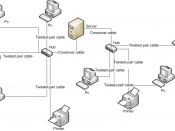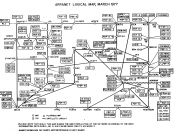According to Wikipedia, telecommunication is defined as "the transmission of signals over a distance for the purpose of communication". At first this process involved using smoke signals, drums or heliograph. But today, it involves the sending of electromagnetic waves by electronic transmitters. There are three elements of telecommunication. A transmitter that takes information and converts it to a signal, a transmission medium over which the signal is transmitted and a receiver that receives the signal and converts it back into usable information.
In April 1839, Sir Charles Wheatstone and Sir William Fothergill Cooke constructed the first commercial electrical telegraph. It used the deflection of needles to represent messages and operated at a distance of up to 21 kilometres. They both thought of their device as an improvement to the existing electromagnetic telegraph. In 1866 the first transatlantic telegraph cable was completed which allowed transatlantic telecommunication for the first time.
TAT-1 was the first cable connection, which was installed in 1956.
It provided 36 telephone circuits. In 1940 George Stibitz was able to transmit problems and received the computed results using teletype to his Complex Number Calculator. This configuration of a centralized computer or mainframe with remote dumb terminals remained popular throughout the 1950s. However in 1960s researchers started to investigate packet switching. This is a technology that would allow chunks of data to be sent to different computers without first passing through a centralized mainframe. ARPANET network emerged in 1969. This was a four-node network. It connected the University of California - Los Angeles, the Stanford Research Institute, the University of Utah and the University of California - Santa Barbara.
ARPANET's development centred on the 'Request for Comment' (RFC) process and in 1969, RFC 1 was published. ARPANET merge with other networks to form the Internet and many of the...


